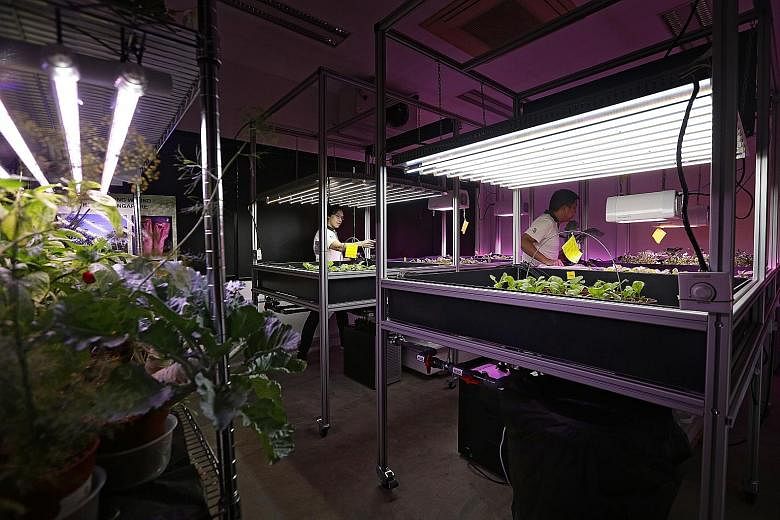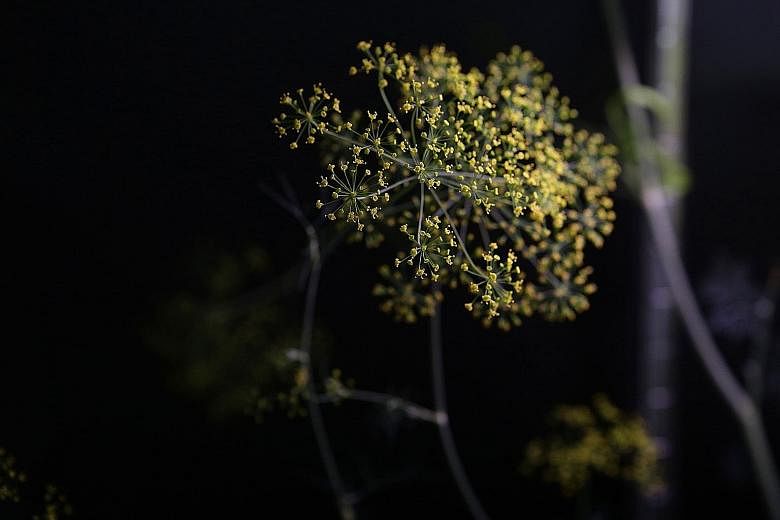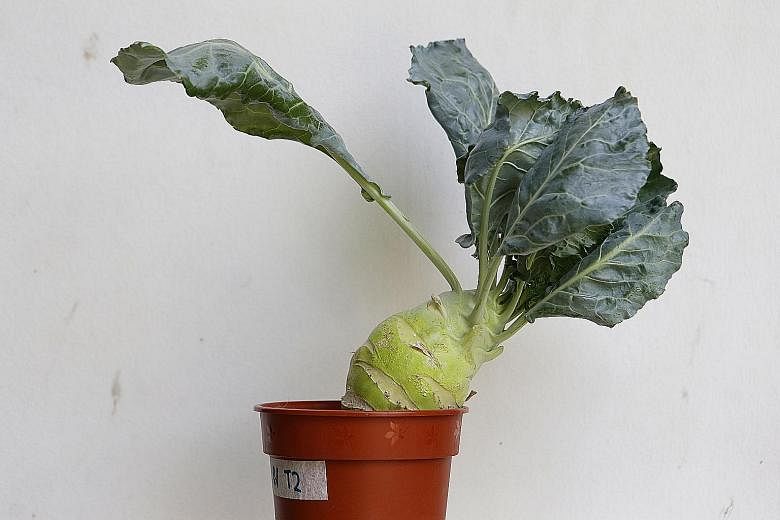Urban farmers here dream of turning the corridors of buildings, their balconies and even living rooms into vegetable patches and herb gardens.
The lack of direct sunlight, however, stands in the way. Many turn to light-emitting diode (LED) grow lights to stimulate plant growth. They emit an electromagnetic spectrum suitable for photosynthesis.
But do they really work?
Horticulturists at the National Parks Board (NParks) have set up an indoor grow room in HortPark to answer just that. It is a typical office meeting room that has been retrofitted with a computer-controlled hydroponic system. The system, which is hooked up to two chillers, has six trays. Each tray comes with an LED grow light and can be flooded and drained at will.
To study how the wavelengths, intensity and duration of light treatment affect plant growth, the trays are separated by black blinds, which are also used to cover the room's windows to prevent sunlight from interfering with the team's experiments.
"We want to get a better understanding of how LED grow lights actually work, how well they work, and which plant species they are more suitable to be used on," said Mr Poh Choon Hock, a researcher from NParks' Centre for Urban Greenery and Ecology (CUGE).
The three-year study started this April, and the team has almost completed its first batch of experiments on 12 plants including capsicum, cauliflower, dill, peppermint and carrot, which are temperate crops.
As a start, they compared the effectiveness of T5 LED light, the most common type of LED used indoors, with a range of grow lights sold by Swedish firm Heliospectra, which was chosen because the light emitted can be customised.
The height, leaf surface area and stem diameter of individual plants were measured, and the number of flowers, flower stalks and buds they grew, and the number of days it took for them to flower, recorded.
Under the T5 LED lights, the plants took longer to flower and fruit. They also had leaves which were larger and darker, which Mr Poh said were adaptive responses by the plant to capture more light for photosynthesis, and show that the light was not adequate for plant growth. Under the grow lights, the plants grew successfully.
Mr Poh however noted that grow light, due to the wavelength of the light, is uncomfortable for humans to look at for long periods of time.
-
ABOUT COMMUNITY GARDEN FESTIVAL
The biennial Community Garden Festival returns for its second year at HortPark. Gardening enthusiasts will get a platform to exchange tips, and the opportunity to learn from experts and pick up bargains from the festival's marketplace. In addition to gardening plots set up by community gardeners, the festival will feature landscape displays created using edible plants, and tours, workshops and cooking demonstrations by celebrity chefs. There will also be floral design competitions and the Community Garden Edibles Competition.
DATE: Nov 3 to Nov 5
TIME: 9am to 7pm
VENUE: HortPark
ADMISSION: Free
More details can be found at www.nparks.gov.sg/gardening/communitygarden-festival
FESTIVAL WORKSHOPS
Growing your own nutrition
TIME: 10am to 11am
VENUE: Multi-purpose hall Learn about how some plants provide high levels of minerals, phyto-chemicals and enzymes, as well as learn how to grow these plants in an urban setting.
Grow high-nutrition microgreens with indoor technology
TIME: 1pm to 2pm
VENUE: Multi-purpose hall Find out about the nutritional values of microgreens - the shoots of young salad plants - and how they can be added to our diet. Also get tips on selecting the latest indoor technology for growing microgreens at home.
The use of science and technology in home farming
TIME: 1pm to 2pm
VENUE: Multi-purpose hall Learn how to grow a variety of vegetables including ladies' finger, pumpkin and long beans, both in soil and through aquaponics. Also learn to use technology to automate growth processes or to incorporate the use of sensors in monitoring the growth of plants.
He added that the leaves of the rocket plant, usually used in salads, tasted more bitter, and the team has not figured out why. Cold weather plants, when not under ideal conditions, become more bitter. But Mr Poh also said it could be because they harvested the leaves late.
Other questions the team could be asking in coming experiments could be how to scale up the production of such plants, and how to induce a plant to produce more fruits.
The team is also studying different irrigation methods.
Director of CUGE Research Benjamin Lee noted that the efficient use of LED grow light, which has been used in space stations to grow edible greens, could also help Singapore improve its local vegetable production and hence its food security.
"The knowledge gained from these experiments can tell us what type of plants can be grown in less sunny conditions and possibly with further application in subterranean conditions since there is so much talk about moving underground."



